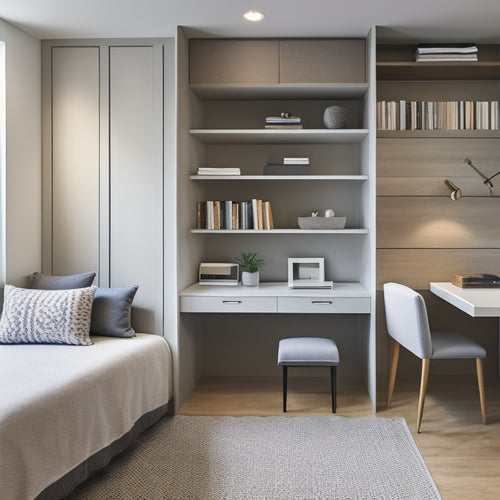
Why Is Organizing Your Home Office So Difficult?
Share
You're not alone in struggling to organize your home office. Unrealistic expectations of perfection can hold you back, making it hard to achieve a functional workspace. Lack of clear goals and vision can lead to clutter and disorganization. Limited space and resources can also hinder your efforts, while emotional attachment to items can make it tough to declutter. Add poor time management skills to the mix, and it's no wonder you're stuck. But understanding these common obstacles is the first step towards creating a productive and organized home office. Now, identify the specific challenges you're facing and start tackling them one by one.
Key Takeaways
• Unrealistic expectations of perfection can hinder home office organization, making it difficult to achieve a functional and organized space.
• Lack of clear goals and vision leads to clutter and disorganization, making it essential to set specific objectives for the space.
• Limited space and resources require creative solutions, such as multi-functional furniture and affordable storage options, to maximize the available area.
• Emotional attachment to items can make it challenging to let go of clutter, but understanding the purpose of each item can help with the decision to keep or discard.
• Poor time management skills can lead to a cluttered workspace, making it crucial to establish task priorities, set realistic goals, and allocate time slots effectively.
Unrealistic Expectations of Perfection
Your pursuit of a perfectly organized home office often begins with an unattainable vision of a space that's always spotless and clutter-free. You imagine a 'perfect score' where everything has its designated place, and not a single paper is out of order.
However, it's crucial to recognize that these unreal standards can be a significant obstacle to achieving a functional and organized workspace.
You set yourself up for disappointment when you expect your home office to look like a magazine cover or a Pinterest board. The truth is, a perfectly organized space is a myth, and it's unrealistic to aim for it.
Instead, focus on creating a space that works for you and your unique needs. Aim for a balance between organization and functionality, rather than striving for an unattainable perfect score.
Lack of Clear Goals and Vision
Without a clear understanding of what you want to achieve in your home office, you'll likely struggle to create a space that truly supports your productivity and workflow. This lack of direction can lead to a cluttered and disorganized space, making it difficult to focus and be productive.
To overcome this, it's essential to set clear goals for your home office. What do you want to achieve in this space? What tasks will you be performing, and what equipment will you need?
Once you have a clear understanding of your goals, you can start to create a vision for your space. Consider creating a vision board, a visual representation of your goals and desires. This can be a fun and creative way to clarify your thoughts and ideas.
By having a clear vision, you'll be able to create a space that's tailored to your specific needs, making it easier to stay organized and focused. Remember, goal setting is an essential step in creating a functional and productive home office.
Take the time to define your goals and create a vision for your space, and you'll be well on your way to a more organized and efficient work environment.
Limited Space and Resources
You're likely to encounter spatial constraints and limited resources in your home office, which can hinder your productivity and organization. With a small space, you'll need to get creative with your furniture arrangement. Optimizing your furniture is important to maximize the available space. Consider investing in multi-functional pieces, such as a desk with built-in storage or a comfortable chair with a built-in ottoman. This will help reduce clutter and create a sense of openness.
Another challenge you'll face is limited resources. You mightn't have the budget to invest in fancy organizational systems or hire a professional organizer. However, with a little creativity, you can still maximize your storage. Look for affordable and versatile storage solutions, such as stackable bins, shelves, and hooks. Label each storage unit so you can easily find what you need.
Difficulty Letting Go of Clutter
Even with a well-organized space and maximized storage, clutter can still accumulate if you struggle to part with items that no longer serve a purpose. This is often due to emotional attachment or sentimental value attached to these items. You may feel guilty getting rid of gifts or items that hold memories, but it's crucial to remember that keeping them doesn't necessarily honor the memory or person.
Here are three common items that are hard to let go of:
-
Old papers and documents: You may think you need to keep them for reference, but often they can be digitized or recycled.
-
Broken or outdated items: You might hold onto them thinking you'll fix or repurpose them, but if you haven't done so in a year, it's unlikely you will.
-
Gifts or hand-me-downs: Remember that the gift or item was given to you, not the other way around. If it no longer serves a purpose, it's okay to let it go.
To overcome this difficulty, ask yourself: 'Does this item bring me joy or serve a purpose?' If not, consider letting it go. By doing so, you'll create space for new, useful items and reduce clutter in your home office.
Poor Time Management Skills
How do you prioritize your tasks when everything seems urgent and important, yet your home office is still plagued by inefficiency and disorganization?
Poor time management skills can lead to procrastination patterns, causing you to put off tasks until the last minute, resulting in a cluttered and chaotic workspace. You struggle to establish a sense of priority, and before you know it, hours have slipped away, and you've accomplished little.
You're not alone in this struggle. Many people face priority struggles, unsure of where to focus their attention.
To break this cycle, start by identifying your most critical tasks and allocate specific time slots for each one. Create a schedule and stick to it. Set realistic goals and deadlines, and avoid multitasking, which can further decrease productivity.
Frequently Asked Questions
How Do I Stay Motivated to Organize My Home Office for an Extended Period?
"When tackling the organizational marathon, you're not a lone wolf; set up a reward system to fuel your progress and enlist an accountability partner to keep you on track, ensuring a triumphant finish."
Can a Home Office Be Organized if It's Used for Multiple Purposes?
You can organize a multi-purpose home office by implementing zone segregation and space prioritization. Designate specific areas for each function, and allocate space based on importance and frequency of use.
What Tools or Software Are Best for Organizing Digital Office Files and Documents?
You'll find cloud storage services like Google Drive, Dropbox, or Microsoft OneDrive ideal for organizing digital office files and documents, as they offer intuitive file systems and seamless collaboration features.
How Often Should I Declutter and Reorganize My Home Office to Maintain Its Organization?
You should aim to do a seasonal purge every 3-4 months to tackle clutter, and commit to daily maintenance habits, like tidying up for 10 minutes, to maintain your home office's organization and maximize productivity.
Are There Any Specific Organizing Techniques for People With ADHD or Other Neurodiverse Conditions?
You'll find flexible frameworks for focus, like Visual Systems and Color Coding, specifically designed to support neurodiverse minds, helping you categorize, prioritize, and maintain your home office organization, making it a sanctuary for productivity.
Related Posts
-

What's the Secret to Organizing Digital Clutter?
You're tired of feeling overwhelmed by digital mess, wasting time searching for lost files and drowning in a sea of d...
-

Why Cluttered Bedrooms Are a Thing of the Past
You've finally said goodbye to cluttered bedrooms, thanks to innovative storage solutions that have revolutionized th...
-

10 Best Space-Saving Hacks for Tiny Guest Rooms
You're about to transform your tiny guest room into a cozy retreat that's both functional and aesthetically pleasing....


